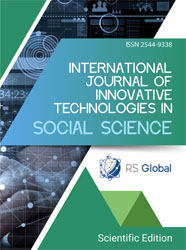THE USE OF ARTIFICIAL INTELLIGENCE IN ANALYZING HISTORICAL DEMOGRAPHIC DATA
Abstract
This paper aims to highlight the most significant artificial intelligence technologies and tools employed in processing historical demographic data, and explores the primary challenges that arise after their implementation. Advanced AI technologies have revolutionized the analysis of historical demographic data and the prediction of future trends, what enhances our understanding of the past and addresses gaps in historical records. Nevertheless, several challenges emerge, including the accuracy of historical events that involve demographic, social, cultural, and economic aspects of populations and the various phases they have experienced, such as data distortion, bias, and ethical issues. These challenges may undermine the credibility of information for current or future generations and lead to decisions and predictions with substantial implications for social, health, and economic policies.
References
Abdel Wahab, S. (2023). The Effectiveness of Some Artificial Intelligence Applications in Developing E-Learning Skills and Self-Regulation Among Students of Educational Technology with High and Low Cognitive Capacity. Journal of Studies and Research in Qualitative Education, 9(4), 22, Assiut University.
Al-Assad, S. (2022). The Negative Ethical Concerns of Artificial Intelligence Technologies: The Case of Deepfake Technology. Journal of Media Studies, 6(2).
Al-Chawadfi, J., & Hajjaj, A. (2013). Artificial Intelligence and Time Series Analysis. Scientific Journal of the Commerce Sector, Al-Azhar University, 10.
Arab Democratic Center. (2019). Research Methodology and Techniques in Social Sciences. Berlin: Arab Democratic Center.
Basal, M. (2022). Research Methodology – Definition, Steps, Advantages and Disadvantages. Journal of Studies, 11(2).
Hali, M. (2014). The Evolution of Historical Demography in the Context of New History. Historical Kan Periodical, 24.
Khadra, R. (2018). Historical Demography: Its Nature and Importance. Journal of Introductions, 7.
Mohammed, A. (2020). Research Methods in Social and Human Sciences. Al-Noor Electronic Library. Available at: https://www.noor-book.com/
Samairi, H. (2023). An Approach to Historical Demography through Books of Biographies and Classes: Scholars of Africa from the Mid-8th Century to the End of the 15th Century as a Model. Myth Journal, 18.
Ashour, M. A. H., Al-Dahlan, I. A. H., & Sherzad, S. S. (2023). Utilizing Artificial Intelligence for Accurate Population Predictions for Iraq Through 2030. In IEEE 11th Conference on Systems, Process & Control (ICSPC) (pp. 17-21). Malacca, Malaysia.
Castex, D., &Cartron, I. (Eds.). (2007). Epidemics and Mortality Crises of the Past (1st ed.). Ausonius Éditions. https://doi.org/10.4000/books.ausonius.657
Garza Oloa, J. (May 2024). Generative AI vs. Predictive AI vs. Hybrid AI. American Journal of Biomedical Science and Research. Translated from English to Arabic via www.onlinedoctranslator.com.
Dupâquier, J., & Rosental, P.-A. (n.d.). Historical Demography. Encyclopædia Universalis. Retrieved from https://www.universalis.fr/encyclopedie/
United Nations Department of Economic and Social Affairs, Population Division. (n.d.). Multilingual Demographic Dictionary. Retrieved from http://fr-ii.demopaedia.org
Cain, D. (August 14, 2023). Decoding History: The Role of AI in Unearthing Ancient Secrets. LinkedIn. https://www.linkedin.com/pulse/ai-study-history-david-cain
Ismail, M. (September 30, 2023). The Role of Artificial Intelligence in Historical and Civilizational Studies. Paper presented at the Artificial Intelligence Conference, Tanta University, Egypt. Available at: https://www.alraialaraby.com/?p=76724
Noble, J. (May 24, 2024). What are ARIMA models? Available at: https://www.ibm.com. Retrieved on January 30, 2025, at 19:41.
Views:
1182
Downloads:
949
Copyright (c) 2025 Fatma Amri, Rania Haddar

This work is licensed under a Creative Commons Attribution 4.0 International License.
All articles are published in open-access and licensed under a Creative Commons Attribution 4.0 International License (CC BY 4.0). Hence, authors retain copyright to the content of the articles.
CC BY 4.0 License allows content to be copied, adapted, displayed, distributed, re-published or otherwise re-used for any purpose including for adaptation and commercial use provided the content is attributed.











